Feature Interview with Mike Young
September, 2009
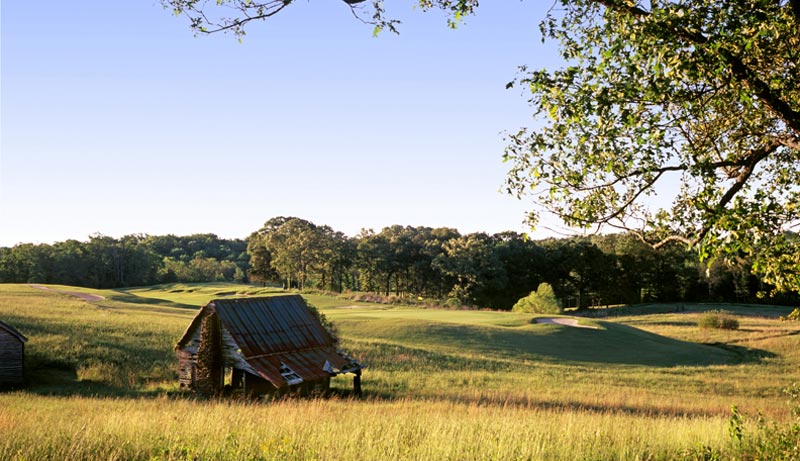
The pump house at Catechee Golf Club, Hartwell, Ga
1. How did you become interested in golf architecture?
When I was in the ninth grade, I observed a golf course being built in my hometown. At the time, my father urged me stay involved in boy scouts until I received my Eagle award (SORT OF OUT OF COOL TODAY). One of the benefits to this – not that I knew it at the time – was that each Eagle Scout was sent to Atlanta every year for the mentor banquet, and would be assigned a mentor for a day. The location of the banquet was the new (built in 1965) Hyatt Regency Hotel in Atlanta which had been designed by the architect John Portman. They put me at a table with 12 guys wanting to be architects and the mentor was John Portman. First thing he says was “I know nothing about golf courses†but there is a guy in town doing several. He sent me to Fairington Golf Club in Atlanta that was being designed by RTJ. When I met with one of his associates who was on site that day, he suggested that the best way to get into the business was through the turf industry – I thought he was crazy! And I didn’t pay any attention to him, until about six years later when I realized that he was right. I applied a several “golf and turf†places and I got a sales job with a Toro distributorship, which gave me the ability to travel from course to course, meet with superintendents, and gather a collection of pictures and slides of many different courses. Gradually, I began to better understand and appreciate the business.
2. What was the first golf course that you designed?
My first golf course was The Fields in LaGrange, GA, which I started working on around 1985. It was a design/build type of project, and I was fortunate enough to come across a guy who had been in the turf grass industry and who wanted to build a golf course on his farm. I convinced him to let me do the job, and this became our first project. While we were there we networked with a couple of other people and were able to solidify two other jobs. The site was along Interstate 185, and it was a wide-open rolling area of land with water so it was actually a very easy site to work with. One of the owners was a dentist and he actually did his own irrigation system…and did an excellent job.
3. Is it important for architects to have a sense of the evolution of golf course architecture?
I think it is extremely important. The key word is evolution. I think it is a rare situation indeed when we need to take a course back to where it was at some earlier point in time. Not to say we can’t adhere to the same features and aesthetics that define such but all of the hype surrounding the restoration just goes over my head. Let’s look at what has evolved in golf courses….
A) MAINTENANCE-the maintenance levels and conditions have taken greens contours to less slope with many pin placements on greens now being designed at 1 percent to 1.5 percent slope. The ability to mow fairways at such low levels have allowed for more consistent iron play on the top amateur and professional levels as well as increasing distance due to lower heights of cut. The modern bunker is groomed to such a level of consistency that many modern players view such hazards as the norm and complain if hazard conditions vary. But just because something evolves doesn’t mean it is good. The maintenance perception is going to have to change for many or most of the courses in the United States if they are to be profitable. For the majority of golfers if you can provide a good putting surface they can accept less in the other areas on most days, knowing that a course can be brought up to certain standards on special occasions. Continuous cartpaths are now the norm and not the exception. How much cart traffic should we have in order to need full cartpaths? 30,000 rounds? The modern golfer has come to critique the cart path as much as the course. We can get by with much less cart path.
B) DESIGN- in my opinion the biggest design evolution to take place in modern architecture is the increased shaping of fairways. Of course that has also allowed projects to be built on unacceptable land. I wish I could take credit for the term “perimeter weighted fairways” which someone on the site came up with…..we see so much more of that. I built one project in Atlanta where the owner got into so many unnecessary battles with the county that we were required to catch all water from each fairway within each fairway. And then drain each one separately into the pond. I bet we used 500 catch basins. Not something I like to brag about.
I think we see many more greens with surrounding reinforcement than in the past thus making the recovery shot much easier where so many of the older courses were push up greens on unshaped land. I think most of the really good old courses have much more “verticality” between the surrounds and the putting surfaces. This makes a “short side” a much more difficult situation than with a reinforced “framed” green.
I think the modern bunker is an overbuilt fiasco. It is a frigging hazard. There will be days when it will be wet (I don’t mean poor drainage) so let it be wet. It is not uncommon now for some courses to have a budget item for bunker sand that is shipped from 1000 miles away. One architect told me he had 12 acres of bunker sand four inches deep that was shipped 800 miles.
I think if we could change one thing in modern design it would be to go back towards greens with overall back to front slope whereby the approach strategy was more to get the ball below the hole instead of to place the ball a specific distance to the attain the proper green tier. That’s my two cents on this.
4. How does your work as a modern architect compare to the golf architects of the past?
I would say that I’m probably misunderstood, because I’m actually more of a realist rather than idealist. GolfClubAtlas.com has a very idealistic nature, in regard to the work of past architects. I think that many architects today are better than those of the past; although they did a great job they had a completely different work ethic and environment. In reality, they could not get around as easily and did not have the detailed plans that architects today have, because of a lack of resources. But they enable a fantastic mythology. So much of what people enjoy about the older architecture is simply a matter of evolution. I give them credit for the basic green slants and the bunkering, but everything else is dependent upon a club’s budget and the golf superintendent. However, I do admire the golf architects of the past, and I enjoy studying their work, but I do not want to get involved in the hype. It is interesting how some people attempt to make a career based on the work of a past architect or by restoring an older course. I ask myself if I would want a person playing with my work 75 years from now that had a large body of his own work or just went from one old guy to the next restoring courses……I don’t know….I like much of the work of some of these restoration guys……..I guess one just has to do their thing…
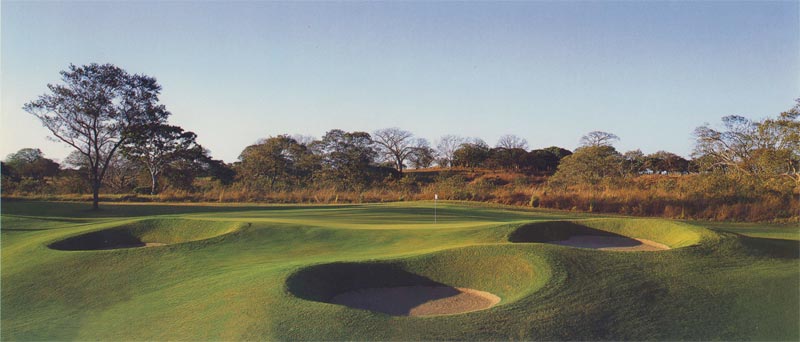
The par three 11th hole at Hacienda Pinilla Golf Club, Costa Rica
5. What’s the shortest length eighteen hole course that you have built? Do you think an owner will ever have the guts in this day and age to commission a 6,400 yard course, even though it would suffice for 90+% of all golfers?
I think I built one at 5800 yards about 10 years ago. And yes I think there are owners that would build such again…BUT…would they put it on the scorecard?
How many times have any of us really played a 7200 yard course at 7200 yards….I know it is not often for me. All the 7000 barometer does is help market a project. If clubs required the additional maintenance required for the extra length to be divided amongst the players playing from that length then we would probably solve the length problem quickly.
6. You live and are based in the southeast of the United States where the summers tend to be hot and humid with afternoon thunderstorms thrown in for good measure. Given such conditions, is there any way to have courses play fast and firm June through September?
Sure. Many summers they are baked. But if not……Plant the right grasses…get the right air movement and sunlight and keep the water to a minimum with sheet drainage across your fairways. Seems all of us are guilty of catch basins but if we can move the water fast enough we can do it. I have started to cap my approaches and chipping areas with 6 inches of river sand when the owner will allow it. That helps. I don’t think we are that different than some of the bent grass areas of the country. You get the right maintenance personnel and he will do it.
7. What are your top five courses in Georgia to play and what do you like about each?There are certain common denominators that determine the types of courses I like. I don’t like holes with homes on each side. I like views of the “whole” not the “hole”. I like for greens and tees to be located close to one another. And I like to have to think after each shot. I don’t always get to build such but doesn’t mean I can’t like it.
OK…I get to name at least one of my own. And none of these are in any specific order.
A. I have got to take my Longshadow course in Madison. I like the open areas, the interior routing and the feel I get with it. I think it is a good course that can be played every day and will eventually be maintained as it should be.
B. Peachtree in Atlanta is just a good golf course routed much like Augusta and maintained well. And it has so many inherent intangibles connected to it.
C. Augusta National always has to be there. I have been fortunate to play enough times to appreciate for more than the tournament. When the green speed is down around 10 it is a very fair golf course. With no disrespect intended…it is a course that could be as good a public course as it is a private monument.
D. Settindown Creek in Atlanta is a course I could play every day and a course that may be the best strategic course in the area. It has a good architect in Bob Cupp but it may have one of the best superintendents in the country (and smartest) Courtney Young. This cat keeps right on top of it along with it being a good course.
E. Athens Country Club is another. It is my home course and is a Donald Ross. Of course he was only there for one day so some of the members think he forgot a few things. But after a séance we are going forward with a “restoration” and I question if we are doing the right thing but then again……I only had one vote (only passed by 9 votes out of around 600 cast)
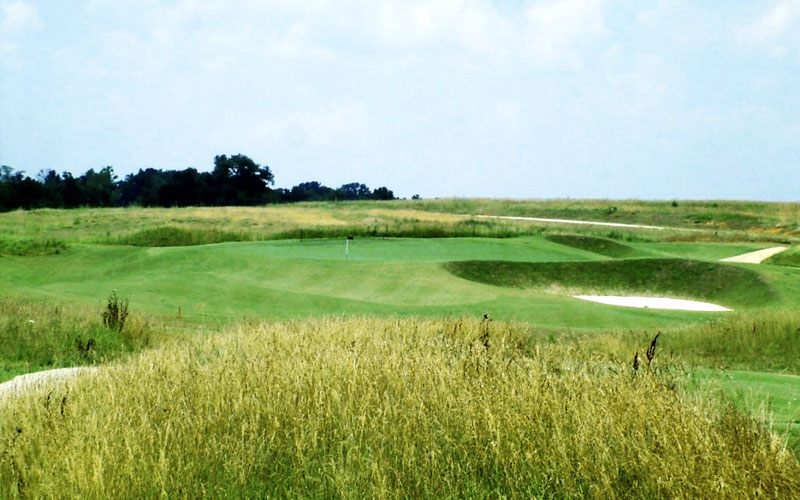
The par three 17th at Long Shadow Golf Club, Madison, GA
8. Name a course that you didn’t build that you imagine was a) inexpensive to construct and b) has stood the test of time. Has this course held influence over you throughout your design career?
I guess I would say Augusta National. I think the type of rolling land it occupies has enough features present that one can design a very good course if he has total freedom with the routing. That’s also why I think routing is so much more important than many realize. I just can’t see where much dirt was moved. I would like to say it has held influence over my career but that might sound a little cocky here. But I do think I have subconsciously referred to its features when routing. It is such a good course at moving water across fairways and not down them….couple of spots such as left bottom of #10 landing area but not many. And hardly any of the landing areas are located in crossing swales. But understand that since I never worked in another firm and had no preconceived notions of how I had to do it…..I just came up with these Mikeisms on my own. And because I started this on my own my clients have been a little different than some of the larger developers and big money guys. But I try to put the bones there and if the right guy ever buys it or a guy comes along that can maintain at a higher level then hopefully the course can improve because of the bones. Does that make any sense?

Clubhouse and 18th green at Cateechee Golf Club, Hartwell, GA
9. In regards to bunker placement, describe one that you have built that confounds/irks many players. What was your inspiration for it?
The first that comes to mind is one I did at Beau Pre in Natchez, Mississippi that sits in the middle of the fairway about 260 off the back tee on a dogleg right hole. It is a fairly simple bunker but so many guys think they are entitled to the middle of the fairway without thinking. One can risk the inside corner between the bunker and a pond or can choose a longer approach by going left OR he can hit a hybrid club or three wood and have a wide open fairway….for some reason most humans just will not choose the third. As for inspiration…I don’t know…I had just seen them a few places.
10. You have never worked for another architect nor are you a member of the ASGCA. What are the pros and cons of literally being on your own?
Oh boy…..I have many friends in the ASGCA. I have tried to get in a couple of times but it did not work out. Remember they are a fraternal organization, a society, not an association. They have a right to choose whomever they wish for their group. Nothing else to say.
Working for another architect? I think that may be the biggest crock in the business. I mean all these guys will put on their resumes that they worked for A, B or C. What did that entail? I bet I have heard a 100 guys say they worked for Pete Dye. What did they do…and for how long? Truth is they probably got a better education than most that work for other architects. At least you were in the field and got a really good idea of what was happening. But in many cases a guy is just stuck in an office and doesn’t get a lot of exposure to the network and contacts of the business.
I’ve had guys condemn me for not working with another architect but I intentionally went at it the way I did. I really did not want to work for another architect and now that I have done it this way I don’t regret it. I called on golf superintendents, professionals, contractors, architects. I got to go to all the GCSAA shows and took thousands of pictures while aggravating the hell out of anybody that would let me. All on an expense account….. And for five years I got to go to Augusta National at least twice a month to call on the Superintendent and his guys. Plus he was nice enough to let me work the tournament every year. I saw a lot of stuff. I saw how different architects operated their offices; I saw the staking of new courses and then got to follow them through construction just by showing up for a sales call with a superintendent. You can’t find a better on the job training. I think time will show that the best security in this business is to get you own name on your own projects as quickly as one can. A guy can get a pretty jaded view of this business working in the office of a large firm.
The first thing an architect has to have is a client. If a young man has been trained in all the latest drafting techniques, read all the right books, worked for all the right offices and has never sold a job….then he will have a difficult time getting work and if he can’t perform after he gets the work then he will not keep getting work. It is a very competitive business. I have learned that there is a lot of pettiness out there and there is nothing to be gained by making negative comments toward anyone’s body of work. I need to spend my time focusing on my work.

Wilson Young, aka Mike’s design associate on his way to another site visit…
11. Having designed many of your forty plus courses in foreign countries, what are the differences between working abroad versus in the United States?
I like working abroad. We usually bring the skilled labor and find the manual labor locally. You often find that you have to improvise or make do with materials that are close but not the same as in the States. You have to be extremely careful with grasses and other materials that may not be as pure as indicated by the supplier. All of that is a problem that has to be addressed early. If you can have your people on site you can shape the course about like you would here but some of the other elements of the design such as the irrigation may be done differently. For example I have had 100 guys trenching at one dollar and hour each instead of a trencher. And in the same amount of time. How about operating the irrigation once it is installed? In many cases I am much better with a very simple controller dependent system than having a central. The locals may not have the ability to operate the more modern system or it may be that labor is so cheap you are better with a cheaper, simpler system for efficiency. AND you provide more local jobs. But the biggest difference I see in the places I have worked with all of the courses and not just mine is the level of maintenance. No where is golf maintained as we do here. And for the average golfer he equates maintenance level to design quality.
The international golf market will be profitable in the future, but I do wonder if golf in other countries will face some of the same problems as golf in America. I have seen 5-8 million dollar golf courses that end up having only 3,000 rounds played per year. This is done in the name of developing resorts and housing projects modeled after American designs, and although they can build the courses for a reasonable price, they lose money through the annual costs of upkeep. Golf courses are being built in countries where there may not even be a thousand golfers in that actual country. Instead, American and European golfers play these courses. So basically, golf needs to wake up, whether it is from the development side, the resort aspect, or the individual’s private golf course. There is still a lot of smoke being blown at us from groups like NGF and we are far from being over the hump on this.
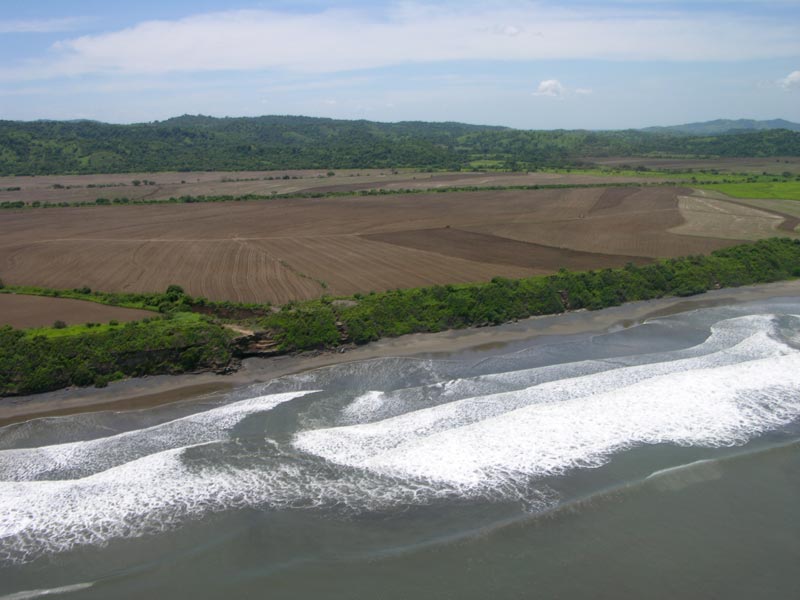
The site of Montecristo Golf Club in Nicaragua
12. Your course in Costa Rica, Hacienda Pinilla, has received glowing reviews. What sets it apart from other Central American courses?
I hope the reviews are good. And I hope they are from good players….so many of the reviews I see regarding International golf courses come from guys that can’t break 100 and they just like the conditions and the setting. I often fear that much of the golf in some of these countries will be judged by tourist and not golfers. Let’s face it…golfers don’t go to 90 degree tropics for the golf.there are too many other places. As for my course at Hacienda Pinilla….I was allowed to route it as I desired and it has a couple of holes on the Pacific…It is walkable and not a very hilly site so that probably sets it apart from the other sites there. The maintenance conditions are pretty good and there are a few little tweaks I continue to work on when allowed so hopefully the good player will like it.
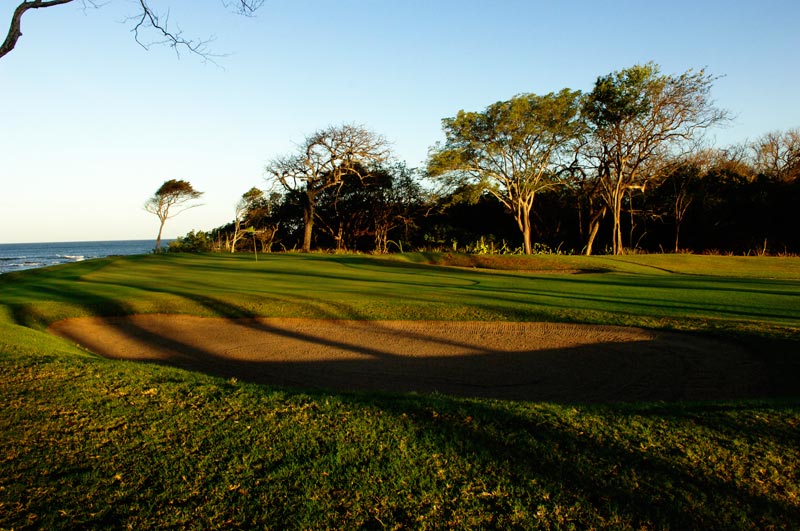
The 15th green on the Pacific at Hacienda Pinilla Golf Club, Costa Rica
13. You have stated that “restoration†is a fad. If this is the case, how much longer will this be popular?
I do believe that restoration is a fad, especially in America. In general, Americans are very gullible, in regard to marketing, and it seems to be very easy to “tell†an American what he likes. However, most American golfers would not play the courses, which they consider to be classics today, had they played them in their original conditions.
While it is true that many of these courses have become “treed†and have modernized bunkers, the basic design is still there – original natural fairway contours, elevated greens, the bunkering as it was meant to be when it was first built, and basic modern maintenance conditions. Now if you can take the above comments and expand them into 40 or 50 pages, make 10 trips to a course to explain such.then you can become a restoration specialist.
Will it change? I think so, just like any other element of society, the next fad in the golf course design cycle will take over. The current fads then become the conditions of the time. However, when a club realizes that they can create a brand identity without paying a signature architect to create a complete remodel, then the restoration fad comes into play.
In my opinion, most “restorations†need to be minimally invasive. If a club wants changes, which require earthmoving equipment, then you may as well build a new course on the same property. Clubs are spending 4 and 5 million on restorations that could be done in a minimally invasive manner for much less. And yet if an architect suggests such, it is disregarded as “cheap†or cutting corners. A lot of people think that I have an aversion to old courses, but this is not the case. When I travel, most of the golf courses I play are the older courses, and this is the type of architecture that I enjoy. I consider myself to be a good perceptual evaluator of the different courses, and in my opinion, it is crucial that clubs take a serious responsibility for how they evolve over time, and not just allow the latest to become the norm.
14. What then do you see as the next fad in golf architecture?
That’s obvious. Fiscal responsibility and GREEN….everyone is talking environmentally sensitive golf courses. It’s no different than we all have been doing it but now it is used as a marketing tool. But it is amazing the big names now promoting a “less is better†strategy toward facilities where just a few years ago they were pushing for 20 million budgets. I think the days of importing bunker sand from 800 miles away are over.
15. What do you see for the future of golf architects?
I think there will be less architects. Golf architects are going to have to become a hybrid. I think that architects, especially the guys that are very entrenched in plans, feel the need to be able to dictate how course should evolve but that will not be the case. And lately it has become very apparent to me that those of us that choose to work in the field with less paper really frustrate these guys. In the past, many people thought that designing a golf course was as simple as just drawing the course on paper and turning it over to a general contractor. And there may still be some of this or at least a form of this. The business will require someone who will be hands-on to get the job done. Too often in the past, we have relied heavily on general contractors, in the future the niche is going to be actually getting the golf course into the ground. I do not predict a lot of large offices with a number of associates. I think most will be one -man shops and many will have their own shaping crews, but they will be more active on site time than has been expected in the past 15 years. Also many of these contractors can build a course without much direction from the architect. Some clubs are beginning to hire contractors without an architect at all, and then just using a professional golfer’s name for publicity and sponsorship. I often think the day of the signature architect is over….most pros cannot charge enough to support an office and a few visits per course compared to what they can charge for a few Monday outings with no risk down the road.
We will know we are where we should be when the consumer really doesn’t know the name of the architect.
16. What do you think will happen with golf itself in the future?
The game of golf needs to wake up. People have mixed opinions on whether or not the game of golf is growing, but in the last few years, golf has been marketed more as a lifestyle than as a game. The courses that wish to be exclusive need to understand that they have to earn it and it cannot be purchased. Many golf courses have been built simply to promote the sale of houses, with excessive budgets and poor land choices. The game of golf, as well as the people involved with the game, needs to be justified. At the end of the day, the golf course needs to make money based on golf. If architects can’t build golf that makes money, then there will be no reason to build golf courses. From where I sit in the golf business, I have a good perspective of the aloofness that is often associated with golf. Whether it be a “foot joy†superintendent, a young associate, an architect who has been in the business for years, or a pro who is working at the new high-end development site, there has always been a certain aloofness toward the other aspects of golf. Aloofness is going to kick a lot of ass in this business soon….However, the interesting part of it is that so many times the individuals with the bloated egos are losing money to the “little†guys and their profitable operations. In other words, the people who are actually making money are not tied to housing or real estate ventures. The mom and pop companies do the work themselves, and when they retire they can sell their land for either golf or housing. I can comment on this aspect of the business because I have worked with these different types of people, and I have built their golf courses. The golf business is somewhat of a Jekyll and Hyde process. Fortunately, I think the aloofness is dying down, and I hope that in the future more emphasis will be placed on how good a golf course was built, rather than who built it. The golf courses that are making money in the United States, in most cases, do not need to advertise nationally. Therefore, many magazines will not be aware of these courses, because they cater to a 20 mile radius.
17. What type of golf course design will be the most prevalent over the next 10-15 years and what trends do you see emerging?
A design that will most likely begin to disappear is something that became popular in the 1980s and 90s. This design involves housing on both sides of the fairways, and architects are probably going to revert back to a style that is based on the “whole†philosophy, rather than the “hole†design. Panoramic landscape views are more pleasing than rows of houses. Many of the courses built in the recent past were built as amenities to a particular type of lifestyle, without much thought being put into the overall operation of the project. My anticipation is that at least a third of these types of golf courses will gradually disappear within the next ten years, since rather than being fully functioning courses; their main purpose is to sell property.
I think it is safe to say that in the coming years, all the courses that are considered great will be built on high-quality pieces of land. The era of taking a piece of land and turning it into a golf course with the help of a marketing company is probably over. I also think that the architects who will get the most acknowledgements in the future will be the ones who have a combination of talent, and most importantly, the most desirable sites. During the 1980s and 90s, there were many unsuccessful courses built, and architects are suffering the consequences of this now, I think things will improve in the future. However, unless it is a resort type golf course that is built, it may not turn much of a profit for the owner. The structure for building golf courses and housing developments in the past needs to change, so that after the development is sold, the course will make a profit.
I think courses may become a little shorter if the new grooves ruling takes place. This will really affect how the long hitters play the game as well as the type of ball they will play. If they want fairways then they will hit three woods and f they want more spin from rough they will hit a higher spinning ball and both of these things will decrease distance.

A Roadrunner at Hacienda Pinilla, Costa Rica
18. What specific elements have made golf courses unprofitable / unsustainable?
I think the number one thing is the golf lifestyle…..the immediate exclusivity that so many try to convey. This is made up in most cases of a clubhouse that can break a golf course in months. The actual golf at many of these places has to subsidize food and beverage, health club, swimming and tennis, yet the boards and general managers will tell people that the golf is losing member’s money while the dining and banquet is profitable. But try closing the golf course for a month and see how much food these places will sell…..then reverse it and close the dining and see how much the golf will drop. Golf wins. And clubs have to wake up and realize such. So many developers stick a club with an oversize clubhouse that was built to benefit selling the community and never evaluated as to how it could be operated once the housing was all sold. The other aspect that causes a problem is having to have pristine maintenance conditions everyday of the week every week of the year. Cut back on mowing fairways, raking bunkers, etc….take care of the greens and much will be forgiven…
19. In conclusion, please sum up your philosophy on golf course design.
Basically, my philosophy is to try to withstand the test of time. A simple strategy is to develop a design that fits the land and the geographic location, and is functional so that the bunkers can be drained, and the sand can be purchased locally. I don’t consider myself an excess bunker person. In most cases, my bunkers are there for strategy and nothing else. I want most of my features to be subtle, hoping that the golfer is surprised more by the simplicity of the design rather than the dramatics. My overall philosophy on design is to keep it simple, basic, and strategically viable, in order to promote longevity.
The End








